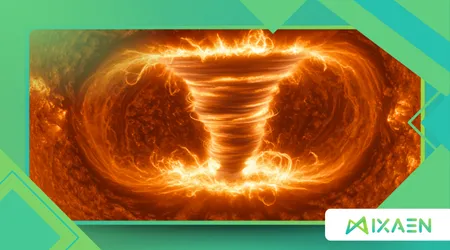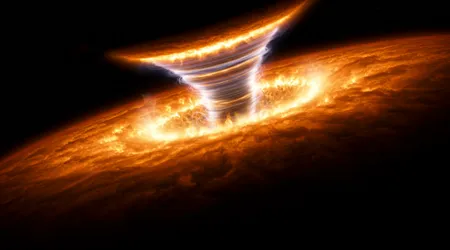Solar Tornadoes: What They Are and Why They Matter

Solar Tornadoes twist through the Sun’s atmosphere, captivating scientists and skywatchers alike. These swirling plasma storms, driven by magnetic chaos, aren’t just cosmic spectacles; they hold keys to understanding solar dynamics and their impact on Earth.
Anúncios
In 2025, as solar activity peaks during the 25th solar cycle, studying these phenomena is more critical than ever.
This article dives into the science, significance, and real-world implications of solar tornadoes, blending cutting-edge research with practical insights.
Why do these fiery twisters matter? Let’s explore their nature, their role in space weather, and their influence on our technology-driven world.
The Science Behind Solar Tornadoes
Imagine a cosmic dance where plasma swirls at 186,000 miles per hour. Solar tornadoes form when magnetic fields in the Sun’s chromosphere twist, creating spiraling filaments of superheated gas.
These structures, often thousands of times larger than Earth’s tornadoes, arise from the Sun’s turbulent magnetic activity.
Unlike terrestrial storms, they’re fueled by nuclear fusion’s energy radiating outward, tangling magnetic fields into violent, rotating columns.
Recent observations from NASA’s Solar Dynamics Observatory reveal solar tornadoes can reach temperatures of 250,000°C, far hotter than the Sun’s 6,000°C surface.
++ The Parker Solar Probe: Flying Into the Heart of Our Star
Their rotation stems from microspicules jets of plasma at the Sun’s poles that spin as magnetic lines snap and reconnect.
This process, observed in ultraviolet light by the SOHO satellite, channels charged particles into the corona, amplifying solar wind.
The sheer scale of these phenomena is staggering. A single solar tornado can span thousands of kilometers, dwarfing Earth’s most destructive storms.
Their speed and heat make them critical players in solar atmospheric dynamics, influencing how energy flows from the Sun’s core to its outer layers. Understanding their formation helps scientists predict solar activity patterns.

Why Solar Tornadoes Matter for Space Weather
Space weather shapes our technological world, and solar tornadoes play a pivotal role. These plasma storms can trigger coronal mass ejections (CMEs), hurling billions of tons of charged particles toward Earth.
When these particles collide with our planet’s magnetic field, they spark geomagnetic storms, disrupting satellites and power grids. In 2025, with solar maximum in full swing, such events are increasingly frequent.
A 1989 CME-induced blackout in Quebec left millions without power for days. Solar tornadoes, by feeding energy into the corona, can amplify these risks.
Also read: How NASA Is Studying the Sun Without Getting Burned
Their magnetic disruptions may also scramble GPS signals, as noted by NOAA scientist Rob Steenburgh, affecting navigation systems critical to aviation and shipping. The stakes are high in our interconnected world.
Mitigating these impacts requires advanced forecasting. By studying solar tornadoes, scientists improve models predicting CMEs and solar wind, protecting infrastructure.
For instance, power grid operators can adjust systems to handle induced currents, while satellite operators can shield electronics. These phenomena aren’t just cosmic curiosities they demand proactive defense strategies.
Their Role in Solar Wind and Auroras
The Sun’s polar regions, where solar tornadoes thrive, are hotbeds for solar wind streams of charged particles bathing the solar system.
These storms, swirling along open magnetic field lines, accelerate particles into space, shaping the solar wind’s intensity. This wind, in turn, influences Earth’s magnetosphere, creating stunning auroras but also potential chaos.
On May 10, 2024, a geomagnetic storm driven by solar activity produced auroras visible across the Northern Hemisphere.
Read more: Could a Solar Superstorm Take Down the Internet?
Solar tornadoes contributed by channeling plasma into the corona, amplifying solar wind. While auroras dazzle, the same particles can overload satellite circuits, as seen in past disruptions to communication networks. Their beauty hides a technological threat.
Consider a highway analogy: solar tornadoes are like traffic surges, funneling energy into the solar wind’s flow, sometimes causing pile-ups in Earth’s magnetic field.
Monitoring these storms helps predict auroral displays and safeguard tech. In 2025, with solar activity peaking, understanding this connection is vital for preparedness.
Observing and Studying Solar Tornadoes
Capturing solar tornadoes demands cutting-edge tech. Photographers like Claro, featured in National Geographic, use specialized telescopes to image these swirling plasma filaments.
Time-lapses, like one from April 24, 2025, reveal their dynamic motion, offering scientists raw data to decode their behavior. These visuals are both art and science.
NASA’s Solar Dynamics Observatory and the SOHO satellite provide critical insights. By analyzing Doppler shifts in ultraviolet light, researchers like David Pike and Helen Mason have confirmed the tornadic motion of plasma.
Their work, presented in 2025 at Rutherford Appleton Laboratory, underscores how these storms heat the corona, a mystery in solar physics.
Ground-based observatories complement space-based tools. Facilities in Portugal’s Dark Sky Alqueva region captured a solar tornado on April 24, 2025, aiding global research.
These observations refine predictive models, helping us anticipate solar events. Every image and data point brings us closer to mastering these cosmic tempests.
Practical Implications for Earth
Solar tornadoes aren’t just distant spectacles they affect life on Earth. Their role in triggering CMEs can disrupt power grids, as seen in past blackouts.
In 2025, with solar activity at its peak, industries like aviation, telecommunications, and energy must stay vigilant to avoid costly outages or navigation errors.
Satellite operators face unique challenges. A single geomagnetic storm, fueled by a solar tornado, can damage solar panels or electronics, costing millions.
For example, a 2024 storm disrupted GPS signals, affecting precision agriculture. Proactive measures, like shielding satellites or rerouting flights, can mitigate these risks, but preparation is key.
Individuals can also act. During solar maximum, staying informed via NOAA’s space weather alerts allows businesses and households to brace for disruptions.
Simple steps, like backing up critical data or using surge protectors, can safeguard against geomagnetic-induced power spikes. Awareness turns cosmic threats into manageable risks.
Table: Key Characteristics of Solar Tornadoes
| Feature | Description |
|---|---|
| Size | Thousands of kilometers wide |
| Speed | Up to 186,000 miles per hour |
| Temperature | ~250,000°C, per NASA’s SDO observations |
| Location | Sun’s chromosphere, often at poles |
| Impact | Triggers CMEs, solar wind, auroras |
Source: NASA Solar Dynamics Observatory, 2025
The Future of Solar Tornado Research
As we navigate 2025’s solar maximum, research into solar tornadoes is accelerating. Scientists aim to unravel how these storms heat the Sun’s corona, a puzzle that could unlock new energy insights.
Advanced telescopes, like the upcoming Daniel K. Inouye Solar Telescope, promise sharper images and deeper data.
Artificial intelligence is transforming analysis. Machine learning models now predict solar tornado activity by scanning magnetic field patterns, improving space weather forecasts.
These tools, tested in 2025, could reduce the economic impact of geomagnetic storms by giving industries more lead time to prepare. The future is proactive.
Collaboration is key. Global observatories, from Hawaii to Portugal, share data to build a comprehensive picture of solar dynamics.
By pooling resources, scientists can refine models, making predictions more accurate. This collective effort ensures solar tornadoes become less a threat and more a window into the Sun’s secrets.
Frequently Asked Questions
What causes solar tornadoes?
They form when magnetic fields in the Sun’s chromosphere twist, spinning plasma into tornado-like structures, driven by nuclear fusion energy.
Can solar tornadoes directly harm Earth?
No, but they trigger CMEs, which can disrupt power grids, satellites, and GPS, as seen in the 1989 Quebec blackout.
How often do solar tornadoes occur?
NASA estimates up to 11,000 exist at any moment, especially during solar maximum, like in 2025.
How are solar tornadoes observed?
Specialized telescopes and satellites, like NASA’s SDO, capture images and ultraviolet data, revealing their motion and structure.
Why study solar tornadoes?
They help predict space weather, protecting technology and infrastructure from geomagnetic storms, vital in our tech-dependent world.
This exploration of solar tornadoes reveals their beauty and power. From fueling solar wind to threatening tech, they demand our attention.
As we advance in 2025, harnessing their secrets through research and observation will safeguard our planet. Stay curious how will these cosmic storms shape our future?
